An official website of the United States government
 United States Department of Labor
United States Department of Labor
Operate or tend machinery at surface mining site, equipped with scoops, shovels, or buckets to excavate and load loose materials.
Employment estimate and mean wage estimates for Excavating and Loading Machine and Dragline Operators, Surface Mining:
| Employment (1) | Employment RSE (3) |
Mean hourly wage |
Mean annual wage (2) |
Wage RSE (3) |
|---|---|---|---|---|
| 40,240 | 3.0 % | $ 23.32 | $ 48,500 | 0.8 % |
Percentile wage estimates for Excavating and Loading Machine and Dragline Operators, Surface Mining:
| Percentile | 10% | 25% | 50% (Median) |
75% | 90% |
|---|---|---|---|---|---|
| Hourly Wage | $ 15.22 | $ 17.61 | $ 21.70 | $ 27.32 | $ 34.06 |
| Annual Wage (2) | $ 31,660 | $ 36,630 | $ 45,150 | $ 56,820 | $ 70,840 |
Industries with the highest published employment and wages for Excavating and Loading Machine and Dragline Operators, Surface Mining are provided. For a list of all industries with employment in Excavating and Loading Machine and Dragline Operators, Surface Mining, see the Create Customized Tables function.
Industries with the highest levels of employment in Excavating and Loading Machine and Dragline Operators, Surface Mining:
| Industry | Employment (1) | Percent of industry employment | Hourly mean wage | Annual mean wage (2) |
|---|---|---|---|---|
| Nonmetallic Mineral Mining and Quarrying | 8,900 | 9.03 | $ 21.98 | $ 45,720 |
| Other Specialty Trade Contractors | 7,850 | 1.13 | $ 22.22 | $ 46,220 |
| Utility System Construction | 4,550 | 0.82 | $ 24.77 | $ 51,510 |
| Highway, Street, and Bridge Construction | 3,520 | 0.98 | $ 21.95 | $ 45,650 |
| Coal Mining | 2,760 | 6.40 | $ 29.05 | $ 60,420 |
Industries with the highest concentration of employment in Excavating and Loading Machine and Dragline Operators, Surface Mining:
| Industry | Employment (1) | Percent of industry employment | Hourly mean wage | Annual mean wage (2) |
|---|---|---|---|---|
| Nonmetallic Mineral Mining and Quarrying | 8,900 | 9.03 | $ 21.98 | $ 45,720 |
| Coal Mining | 2,760 | 6.40 | $ 29.05 | $ 60,420 |
| Metal Ore Mining | 1,150 | 2.84 | $ 25.66 | $ 53,370 |
| Other Specialty Trade Contractors | 7,850 | 1.13 | $ 22.22 | $ 46,220 |
| Highway, Street, and Bridge Construction | 3,520 | 0.98 | $ 21.95 | $ 45,650 |
Top paying industries for Excavating and Loading Machine and Dragline Operators, Surface Mining:
| Industry | Employment (1) | Percent of industry employment | Hourly mean wage | Annual mean wage (2) |
|---|---|---|---|---|
| Electric Power Generation, Transmission and Distribution | 280 | 0.07 | $ 34.41 | $ 71,580 |
| Oil and Gas Extraction | 50 | 0.04 | $ 32.83 | $ 68,290 |
| Foundation, Structure, and Building Exterior Contractors | 250 | 0.03 | $ 30.38 | $ 63,200 |
| Nonresidential Building Construction | 670 | 0.08 | $ 30.21 | $ 62,830 |
| Coal Mining | 2,760 | 6.40 | $ 29.05 | $ 60,420 |
States and areas with the highest published employment, location quotients, and wages for Excavating and Loading Machine and Dragline Operators, Surface Mining are provided. For a list of all areas with employment in Excavating and Loading Machine and Dragline Operators, Surface Mining, see the Create Customized Tables function.
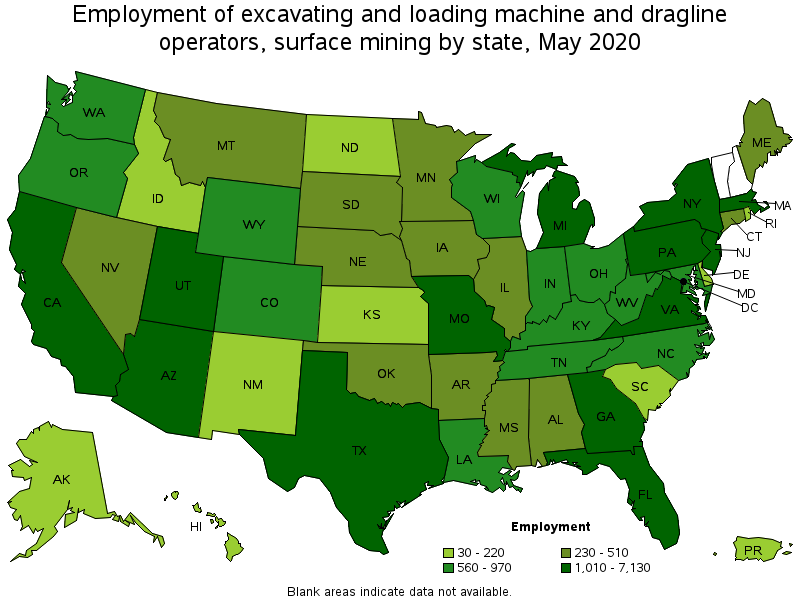
States with the highest employment level in Excavating and Loading Machine and Dragline Operators, Surface Mining:
| State | Employment (1) | Employment per thousand jobs | Location quotient (9) | Hourly mean wage | Annual mean wage (2) |
|---|---|---|---|---|---|
| Texas | 7,130 | 0.59 | 2.04 | $ 20.27 | $ 42,170 |
| Florida | 2,400 | 0.28 | 0.98 | $ 19.83 | $ 41,250 |
| California | 2,290 | 0.14 | 0.48 | $ 30.06 | $ 62,520 |
| Pennsylvania | 1,650 | 0.30 | 1.04 | $ 20.92 | $ 43,520 |
| Georgia | 1,460 | 0.34 | 1.18 | $ 18.95 | $ 39,410 |
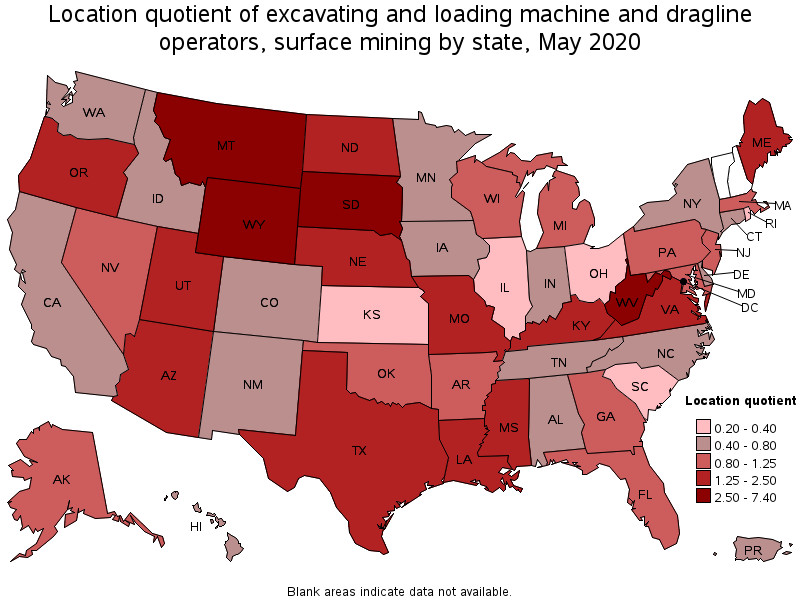
States with the highest concentration of jobs and location quotients in Excavating and Loading Machine and Dragline Operators, Surface Mining:
| State | Employment (1) | Employment per thousand jobs | Location quotient (9) | Hourly mean wage | Annual mean wage (2) |
|---|---|---|---|---|---|
| Wyoming | 560 | 2.14 | 7.40 | $ 33.44 | $ 69,550 |
| West Virginia | 690 | 1.06 | 3.65 | $ 28.01 | $ 58,260 |
| South Dakota | 360 | 0.87 | 3.01 | $ 20.43 | $ 42,490 |
| Montana | 370 | 0.81 | 2.78 | $ 25.30 | $ 52,630 |
| Utah | 1,050 | 0.70 | 2.43 | $ 21.73 | $ 45,200 |
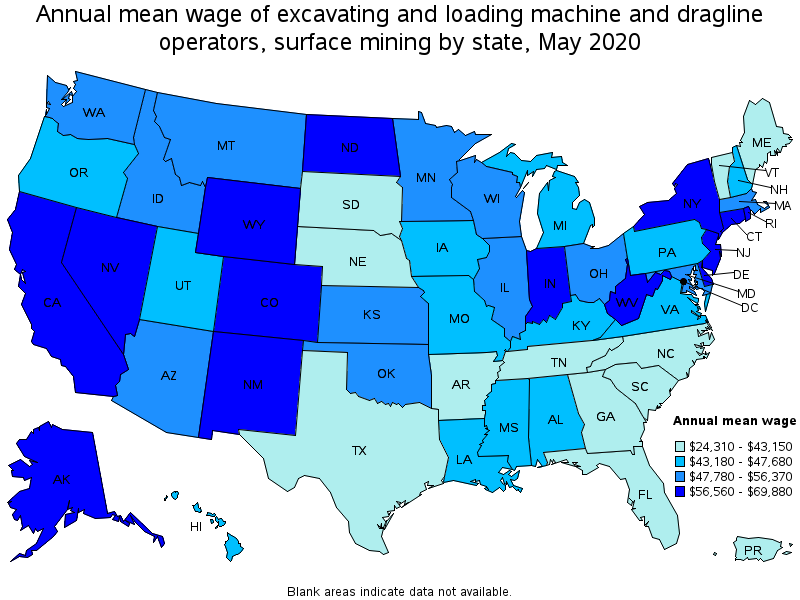
Top paying states for Excavating and Loading Machine and Dragline Operators, Surface Mining:
| State | Employment (1) | Employment per thousand jobs | Location quotient (9) | Hourly mean wage | Annual mean wage (2) |
|---|---|---|---|---|---|
| Alaska | 110 | 0.36 | 1.23 | $ 33.60 | $ 69,880 |
| Wyoming | 560 | 2.14 | 7.40 | $ 33.44 | $ 69,550 |
| North Dakota | 170 | 0.43 | 1.50 | $ 33.00 | $ 68,650 |
| New York | 1,210 | 0.14 | 0.48 | $ 32.54 | $ 67,670 |
| Nevada | 300 | 0.24 | 0.84 | $ 30.67 | $ 63,790 |
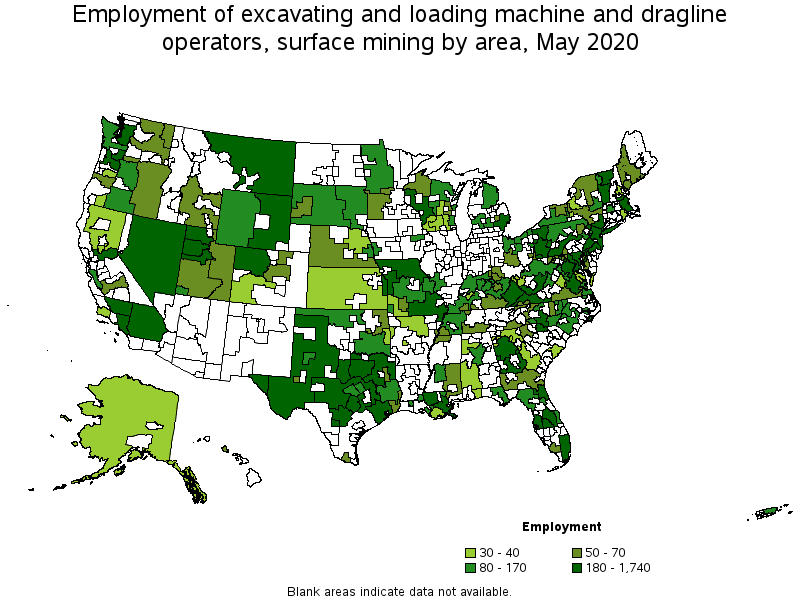
Metropolitan areas with the highest employment level in Excavating and Loading Machine and Dragline Operators, Surface Mining:
| Metropolitan area | Employment (1) | Employment per thousand jobs | Location quotient (9) | Hourly mean wage | Annual mean wage (2) |
|---|---|---|---|---|---|
| Dallas-Fort Worth-Arlington, TX | 1,740 | 0.48 | 1.67 | $ 21.64 | $ 45,010 |
| Houston-The Woodlands-Sugar Land, TX | 1,680 | 0.56 | 1.95 | $ 20.13 | $ 41,870 |
| New York-Newark-Jersey City, NY-NJ-PA | 1,400 | 0.16 | 0.55 | $ 36.20 | $ 75,290 |
| Austin-Round Rock, TX | 910 | 0.86 | 2.97 | $ 21.06 | $ 43,800 |
| Atlanta-Sandy Springs-Roswell, GA | 890 | 0.34 | 1.17 | $ 18.75 | $ 39,010 |
| Boston-Cambridge-Nashua, MA-NH | 840 | 0.32 | 1.12 | $ 23.29 | $ 48,450 |
| Washington-Arlington-Alexandria, DC-VA-MD-WV | 700 | 0.23 | 0.80 | $ 23.16 | $ 48,170 |
| Los Angeles-Long Beach-Anaheim, CA | 620 | 0.11 | 0.37 | $ 27.67 | $ 57,550 |
| Miami-Fort Lauderdale-West Palm Beach, FL | 600 | 0.24 | 0.83 | $ 22.40 | $ 46,600 |
| Orlando-Kissimmee-Sanford, FL | 410 | 0.34 | 1.18 | $ 20.54 | $ 42,730 |
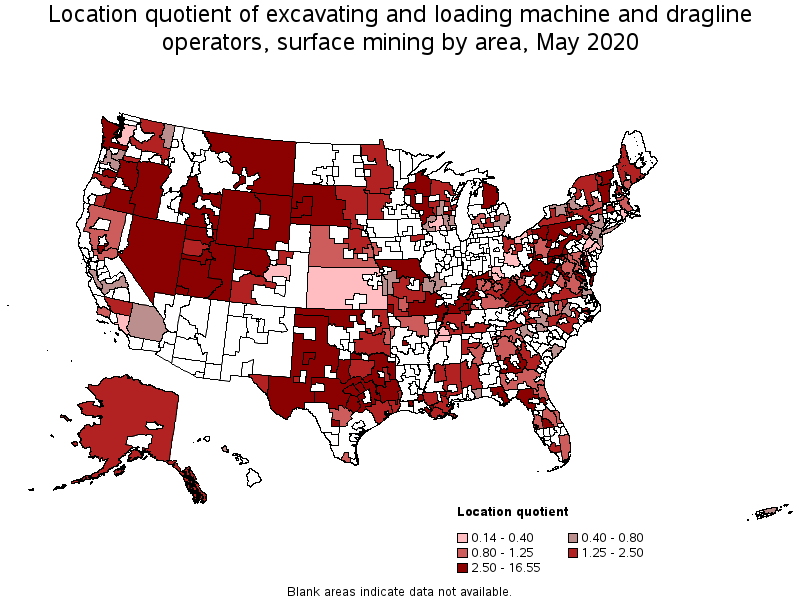
Metropolitan areas with the highest concentration of jobs and location quotients in Excavating and Loading Machine and Dragline Operators, Surface Mining:
| Metropolitan area | Employment (1) | Employment per thousand jobs | Location quotient (9) | Hourly mean wage | Annual mean wage (2) |
|---|---|---|---|---|---|
| St. George, UT | 170 | 2.42 | 8.35 | $ 21.10 | $ 43,880 |
| Cumberland, MD-WV | 60 | 1.70 | 5.88 | $ 18.55 | $ 38,580 |
| Joplin, MO | 130 | 1.64 | 5.69 | $ 21.12 | $ 43,920 |
| Fond du Lac, WI | 70 | 1.57 | 5.41 | $ 29.18 | $ 60,700 |
| Hot Springs, AR | 40 | 1.09 | 3.77 | $ 15.23 | $ 31,680 |
| Albany, OR | 40 | 1.02 | 3.54 | $ 23.51 | $ 48,900 |
| Ithaca, NY | 40 | 0.97 | 3.35 | $ 21.63 | $ 45,000 |
| Provo-Orem, UT | 240 | 0.96 | 3.30 | $ 21.74 | $ 45,220 |
| Rapid City, SD | 60 | 0.93 | 3.23 | $ 17.24 | $ 35,870 |
| Wheeling, WV-OH | 50 | 0.90 | 3.11 | $ 32.47 | $ 67,550 |
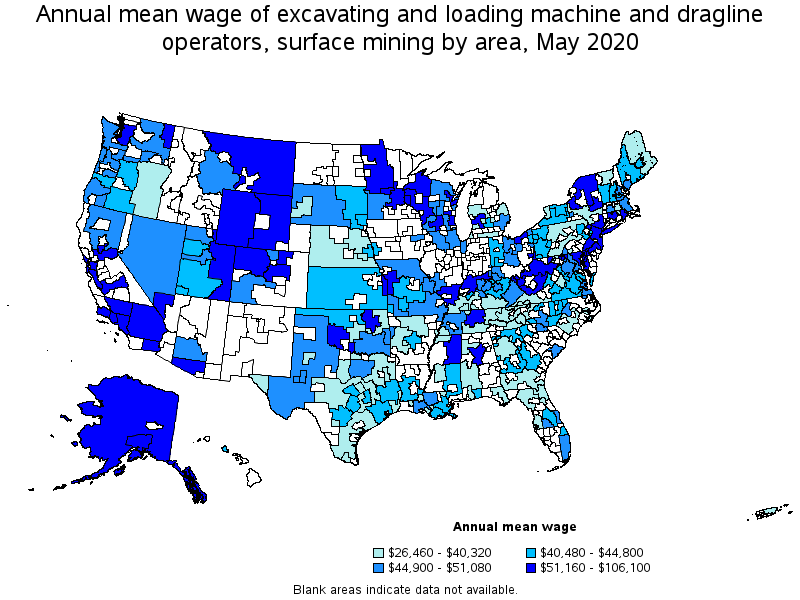
Top paying metropolitan areas for Excavating and Loading Machine and Dragline Operators, Surface Mining:
| Metropolitan area | Employment (1) | Employment per thousand jobs | Location quotient (9) | Hourly mean wage | Annual mean wage (2) |
|---|---|---|---|---|---|
| San Francisco-Oakland-Hayward, CA | (8) | (8) | (8) | $ 51.01 | $ 106,100 |
| Las Vegas-Henderson-Paradise, NV | (8) | (8) | (8) | $ 40.79 | $ 84,840 |
| San Jose-Sunnyvale-Santa Clara, CA | 130 | 0.12 | 0.40 | $ 37.67 | $ 78,360 |
| Anchorage, AK | (8) | (8) | (8) | $ 37.05 | $ 77,060 |
| New York-Newark-Jersey City, NY-NJ-PA | 1,400 | 0.16 | 0.55 | $ 36.20 | $ 75,290 |
| Fresno, CA | 50 | 0.12 | 0.43 | $ 34.35 | $ 71,450 |
| Providence-Warwick, RI-MA | 40 | 0.07 | 0.24 | $ 34.11 | $ 70,950 |
| Huntington-Ashland, WV-KY-OH | 30 | 0.26 | 0.89 | $ 33.69 | $ 70,070 |
| Tulsa, OK | (8) | (8) | (8) | $ 33.60 | $ 69,880 |
| Wheeling, WV-OH | 50 | 0.90 | 3.11 | $ 32.47 | $ 67,550 |
Nonmetropolitan areas with the highest employment in Excavating and Loading Machine and Dragline Operators, Surface Mining:
| Nonmetropolitan area | Employment (1) | Employment per thousand jobs | Location quotient (9) | Hourly mean wage | Annual mean wage (2) |
|---|---|---|---|---|---|
| West Texas Region of Texas nonmetropolitan area | 470 | 2.42 | 8.36 | $ 22.39 | $ 46,560 |
| Eastern Wyoming nonmetropolitan area | 400 | 4.79 | 16.55 | $ 33.54 | $ 69,760 |
| North Texas Region of Texas nonmetropolitan area | 310 | 1.16 | 4.01 | $ 18.83 | $ 39,160 |
| Northwest Colorado nonmetropolitan area | 310 | 2.70 | 9.32 | $ 29.98 | $ 62,350 |
| Hill Country Region of Texas nonmetropolitan area | 300 | 1.57 | 5.43 | $ 18.89 | $ 39,280 |
Nonmetropolitan areas with the highest concentration of jobs and location quotients in Excavating and Loading Machine and Dragline Operators, Surface Mining:
| Nonmetropolitan area | Employment (1) | Employment per thousand jobs | Location quotient (9) | Hourly mean wage | Annual mean wage (2) |
|---|---|---|---|---|---|
| Eastern Wyoming nonmetropolitan area | 400 | 4.79 | 16.55 | $ 33.54 | $ 69,760 |
| Northern Vermont nonmetropolitan area | 280 | 4.22 | 14.60 | $ 19.15 | $ 39,840 |
| East-Central Montana nonmetropolitan area | 210 | 3.24 | 11.19 | $ 28.53 | $ 59,330 |
| Northwest Colorado nonmetropolitan area | 310 | 2.70 | 9.32 | $ 29.98 | $ 62,350 |
| Southern West Virginia nonmetropolitan area | 190 | 2.68 | 9.27 | $ 24.85 | $ 51,700 |
Top paying nonmetropolitan areas for Excavating and Loading Machine and Dragline Operators, Surface Mining:
| Nonmetropolitan area | Employment (1) | Employment per thousand jobs | Location quotient (9) | Hourly mean wage | Annual mean wage (2) |
|---|---|---|---|---|---|
| Eastern Wyoming nonmetropolitan area | 400 | 4.79 | 16.55 | $ 33.54 | $ 69,760 |
| Western Wyoming nonmetropolitan area | 160 | 1.73 | 5.98 | $ 33.05 | $ 68,750 |
| Alaska nonmetropolitan area | 40 | 0.42 | 1.46 | $ 30.21 | $ 62,830 |
| Northwest Colorado nonmetropolitan area | 310 | 2.70 | 9.32 | $ 29.98 | $ 62,350 |
| Western Wisconsin nonmetropolitan area | 180 | 1.32 | 4.55 | $ 29.69 | $ 61,750 |
These estimates are calculated with data collected from employers in all industry sectors, all metropolitan and nonmetropolitan areas, and all states and the District of Columbia. The top employment and wage figures are provided above. The complete list is available in the downloadable XLS files.
The percentile wage estimate is the value of a wage below which a certain percent of workers fall. The median wage is the 50th percentile wage estimate—50 percent of workers earn less than the median and 50 percent of workers earn more than the median. More about percentile wages.
(1) Estimates for detailed occupations do not sum to the totals because the totals include occupations not shown separately. Estimates do not include self-employed workers.
(2) Annual wages have been calculated by multiplying the hourly mean wage by a "year-round, full-time" hours figure of 2,080 hours; for those occupations where there is not an hourly wage published, the annual wage has been directly calculated from the reported survey data.
(3) The relative standard error (RSE) is a measure of the reliability of a survey statistic. The smaller the relative standard error, the more precise the estimate.
(8) Estimate not released.
(9) The location quotient is the ratio of the area concentration of occupational employment to the national average concentration. A location quotient greater than one indicates the occupation has a higher share of employment than average, and a location quotient less than one indicates the occupation is less prevalent in the area than average.
Other OEWS estimates and related information:
May 2020 National Occupational Employment and Wage Estimates
May 2020 State Occupational Employment and Wage Estimates
May 2020 Metropolitan and Nonmetropolitan Area Occupational Employment and Wage Estimates
May 2020 National Industry-Specific Occupational Employment and Wage Estimates
Last Modified Date: March 31, 2021